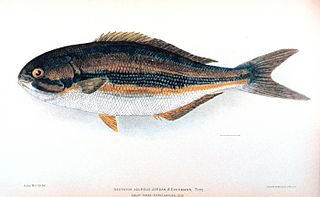
Apiaceae or Umbelliferae is a family of mostly aromatic flowering plants named after the type genus Apium and commonly known as the celery, carrot or parsley family, or simply as umbellifers. It is the 16th-largest family of flowering plants, with more than 3,800 species in about 446 genera, including such well-known and economically important plants as ajwain, angelica, anise, asafoetida, caraway, carrot, celery, chervil, coriander, cumin, dill, fennel, lovage, cow parsley, parsley, parsnip and sea holly, as well as silphium, a plant whose identity is unclear and which may be extinct.
The Percopsiformes are a small order of ray-finned fishes, comprising the trout-perch and its allies. It contains just ten extant species, grouped into seven genera and three families. Five of these genera are monotypic

Groupers are fish of any of a number of genera in the subfamily Epinephelinae of the family Serranidae, in the order Perciformes.

The Exocoetidae are a family of marine fish in the order Beloniformes class Actinopterygii, known colloquially as flying fish or flying cod. About 64 species are grouped in seven to nine genera. While they cannot fly in the same way a bird does, flying fish can make powerful, self-propelled leaps out of the water where their long wing-like fins enable gliding for considerable distances above the water's surface. The main reason for this behavior is thought to be to escape from underwater predators, which include swordfish, mackerel, tuna, and marlin, among others, though their periods of flight expose them to attack by avian predators such as frigate birds.
Squalidae, more commonly known as dogfish, dog sharks, or spiny dogfish, are one of several families of sharks categorized under Squaliformes, making it the second largest order of sharks, numbering 119 species across 7 families. Having earned their name after a group of fishermen reportedly observed the species chasing down smaller fish in dog-like packs, dogfish have slender, streamlined bodies, usually more compact in comparison to other species, and a pointed snout. Dogfish likewise have two dorsal fins, each with smooth spines, but no anal fin, and their skin is generally rough to the touch. As the species reaches adulthood, males usually measure a maximum of 39 inches (990 mm), while females typically measure 49 inches (1,200 mm) long. The species therefore exhibits female-dominant sexual dimorphism.

Notothenioidei is one of 19 suborders of the order Perciformes. The group is found mainly in Antarctic and Subantarctic waters, with some species ranging north to southern Australia and southern South America. Notothenioids constitute approximately 90% of the fish biomass in the continental shelf waters surrounding Antarctica.

Stichaeidae, the pricklebacks or shannies, are a family of marine ray-finned fishes in the suborder Zoarcoidei of the order Scorpaeniformes. Most species are found in the North Pacific Ocean with a few in the North Atlantic Ocean.

Hemiancistrus is a genus of suckermouth armored catfishes. These species are native to South America. The taxonomy of this genus is complex and unclear, and major work has to be done. Many of these fish are popular aquarium fish.

Horabagrus is a genus of catfish in the family Horabagridae endemic to rivers in the Western Ghats in Kerala and Karnataka, India. H. brachysoma is an important food fish and members of this genus can be found in the aquarium trade.

Chub is a common fish name. It pertains to any one of a number of ray-finned fish in several families and genera. In the UK, the term chub usually refers to the species Squalius cephalus. In addition, see sea chub.

Tarasiiformes is an extinct order of prehistoric ray-finned fish.

The danionins are a group of small, minnow-type fish belonging to the family Cyprinidae. Members of this group are mostly in the genera Danio, Devario, and Rasbora. They are primarily native to the fresh waters of South and Southeast Asia, with fewer species in Africa. Many species are brightly coloured and are available as aquarium fish worldwide. Danio species tend to have horizontal stripes, rows of spots, or vertical bars, and often have long barbels. Devario species tend to have vertical or horizontal bars, and short, rudimentary barbels, if present at all. All danionins are egg scatterers, and breed in the rainy season in the wild. They are carnivores, living on insects and small crustaceans.
Tridens is the scientific name for several genera of organisms and may refer to:
Pachycormus is the scientific name for two genera of organisms and may refer to:
Hymenocephalus is the scientific name of two genera of organisms and may refer to:
Ariopsis is the scientific name of two genera of organisms and may refer to:
Dandya is a scientific name for two genera of organisms and may refer to:
Heterotis is the scientific name of two genera of organisms and may refer to:
This page is based on this
Wikipedia article Text is available under the
CC BY-SA 4.0 license; additional terms may apply.
Images, videos and audio are available under their respective licenses.









